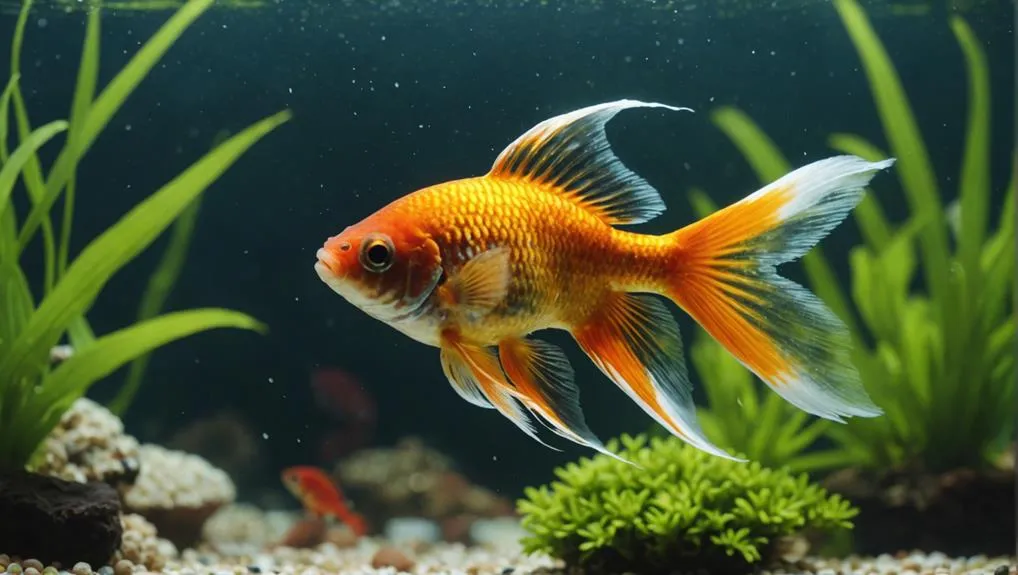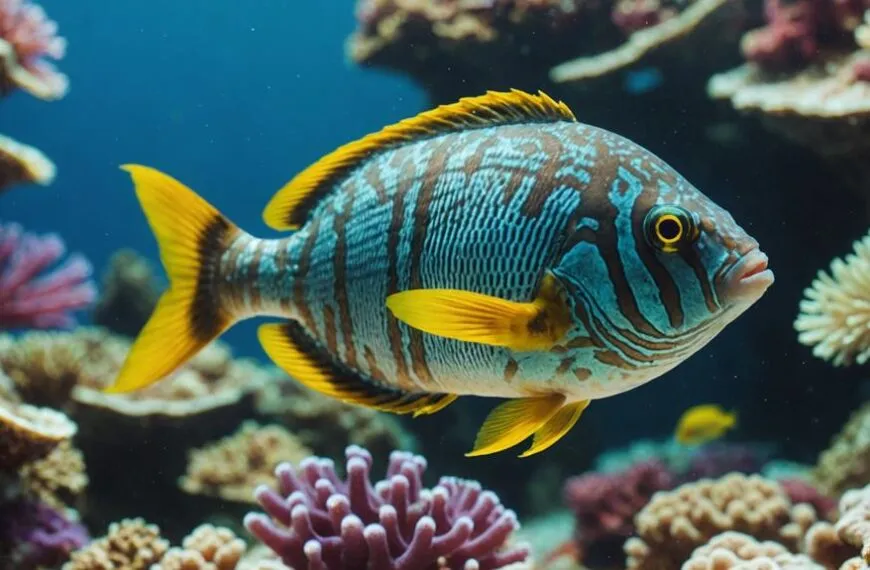Recognizing fish diseases early can save your finned friends from trouble! Keep an eye out for signs like erratic swimming, clamped fins, and changes in appetite that leave food untouched. You might also spot visible skin lesions or bulging eyes, which can indicate infections. Excessive scratching against surfaces is a big red flag too! If your fish starts hanging solo from the group, it's time for concern. Maintaining clean water helps avoid these issues, so always check your tank conditions. Curious about how to keep your fish in tip-top shape? There's more to discover that can help!
Contents
Disorientation and Erratic Swimming
When observing your fish, disorientation and erratic swimming can be alarming signs of underlying health issues. You might notice your fish swimming upside down or in circles, which often points to environmental stress. Erratic swimming, like darting around or crashing into the tank walls, usually suggests stressors such as poor water quality or pesky parasites.
Regular water quality checks are essential to prevent toxic buildup, which can lead to these concerning behaviors monitoring water quality.
If your fish starts to display disorientation, keep an eye out for excessive mucus production or scratching against surfaces. These can indicate potential parasitic infestations like ich or flukes. Changes in swimming patterns, like increased lethargy or isolation from the group, can signal that something's not right.
Regularly monitoring your fish's swimming behavior is crucial. A sudden shift in activity can be an early warning of illness or distress in your aquatic environment.
Remember, your fish depend on you to create a healthy habitat. You're their superhero! So, when you spot these signs, take a deep breath and assess their surroundings. Sometimes, a little adjustment can make a big difference.
Keep swimming through the challenges together, and your fish will thank you in their own little way!
Changes in Appetite
When you notice your fish suddenly leaving food untouched, it might be a sign that something's not quite right. This could indicate stress or illness, which can be exacerbated by poor tank conditions or incompatible tank mates.
You could also see leftover food piling up, which isn't just a messy aquarium; it often points to behavioral changes like lethargy or hiding from tank mates.
Keeping an eye on their appetite is crucial—after all, a happy fish is usually a hungry fish!
tank conditions play a vital role in maintaining their health and appetite.
Decreased Food Intake
Noticing a decreased food intake in your fish can be a red flag for potential health issues. When your fish suddenly shows a decreased appetite, it's essential to observe their behavior and surroundings closely. Sometimes, this change signals stress or illness, and it's crucial to act quickly.
Watch for these signs:
- Lethargy or unusual swimming patterns
- Scratching against objects or gasping for air
- Changes in coloration or visible swelling
Bacterial infections, like Dropsy, can lead to reduced food intake as your fish may not feel comfortable while eating. In some cases, parasites like Fish Ick can cause discomfort, making it hard for your fish to focus on their meals.
Differentiating between a temporary loss of appetite and a serious illness is vital for early detection. Keep a watchful eye on your fish's behavior.
Prompt intervention can often prevent disease progression and improve recovery outcomes. Remember, your fish rely on you to keep them healthy and happy.
Excessive Food Leftovers
Excessive food leftovers in your aquarium can signal a troubling change in your fish's appetite, often pointing to underlying health issues.
When your finned friends suddenly stop gobbling up their meals, it's not just a quirky habit; it could mean stress, illness, or poor water quality is at play. Keeping an eye on how much your fish eat can help you spot early signs of disease before they escalate.
If you notice piles of uneaten food, be alert! This persistent leftover can lead to ammonia buildup in the tank, making the water less hospitable and increasing the risk of sick fish.
You might also see other symptoms like lethargy, clamped fins, or strange swimming patterns. It's like your fish are trying to tell you something's off, and they need your help!
Behavioral Changes Noted
Changes in appetite can be one of the first signs that something's wrong with your fish. If you notice a decreased appetite, it might indicate stress, illness, or even poor water quality. Fish that are feeling unwell often refuse food or seem lethargic.
You may also notice some behavioral changes, like:
- Isolating themselves from the group
- Hiding in corners or behind decorations
- Scratching against objects in the tank
If your fish suddenly stops eating and shows visible white spots, it could be a sign of parasites like ich.
Other conditions, such as Dropsy, can cause significant bloating and a total loss of interest in food. It's essential to keep an eye on their feeding habits. Even a small change might signal the onset of stress-related diseases or infections.
Visible Skin Spots
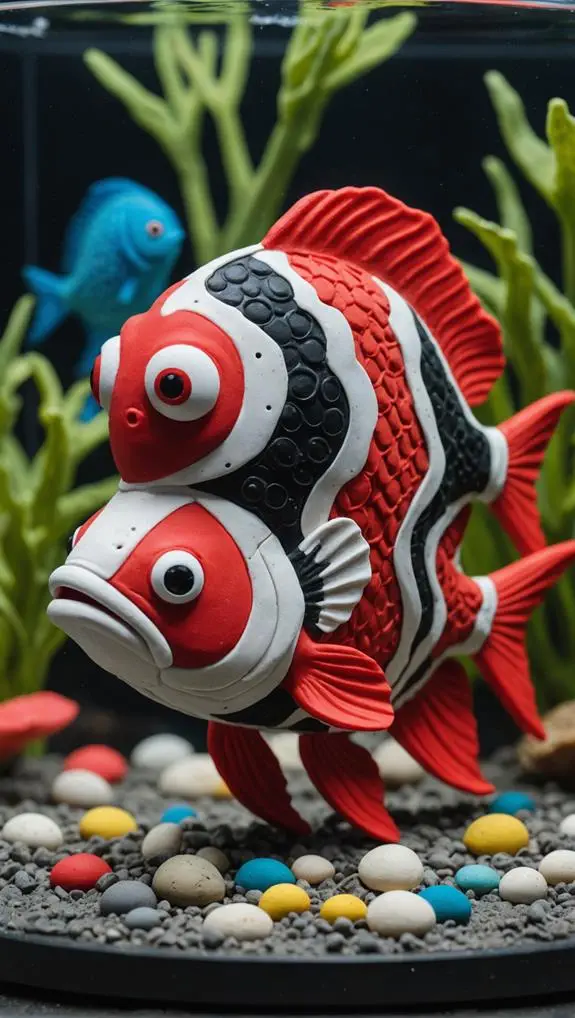
If you notice visible skin spots on your fish, it's time to pay attention.
Those little white spots could mean your fish has Fish Ick, while yellow or gold spots might suggest velvet disease is at play.
Keep an eye out for any unusual patches or lesions because these signs could point to more serious issues, and we all want our finned friends to stay happy and healthy!
Identifying White Spots
One of the most common signs of fish diseases is the appearance of white spots on their skin, which can resemble grains of salt. This condition, known as white spot disease, is often caused by the parasite Ichthyophthirius multifiliis.
If you notice visible white spots on your freshwater fish, it's important to act quickly, as these pesky parasites can lead to serious health issues.
Here are a few things to look out for:
- Increased scratching against surfaces
- Erratic swimming behavior
- Gasping at the water surface, indicating distress
These signs may also indicate that the parasite is attacking your fish's gills, making breathing difficult. If you spot these symptoms, consider using appropriate medications, like copper-based treatments, to help your fish recover.
Quarantining infected fish is crucial to prevent the spread of Ich to other tank inhabitants, as it's highly contagious.
Regular monitoring of your fish and maintaining good water quality can help reduce the risk of outbreaks. Remember, a happy fish is a healthy fish, so keep an eye out for those troublesome white spots!
Causes of Skin Lesions
Skin lesions on fish can arise from various causes, making it crucial to identify the underlying issue quickly. These pesky problems often signal a disease or infection that needs your attention.
One common culprit is parasitic infections, like Ichthyophthirius multifiliis, which gives fish those annoying white spots you might've noticed.
Bacterial infections, such as Columnaris, can also lead to skin lesions, showing up as a grayish-white film on the skin and fins, especially when your fish are stressed or the water's not up to snuff.
Let's not forget about fungal infections like Saprolegnia, which can appear as cottony tufts, usually after injuries or poor water chemistry.
External parasites, including flukes and fish lice, feast on your fish, causing irritation and skin lesions.
Lastly, if you see red or bloody gills, it might be ammonia poisoning, which can also lead to visible skin lesions.
Keeping your tank clean and monitoring water quality is a must.
Your fish rely on you to provide a healthy environment, so stay vigilant and give them the best care possible!
Clamped Fins and Isolation
Clamped fins and isolation are often clear signs that something's not right with your fish. When you notice your fish hanging out alone and keeping its fins close to its body, it's usually a cry for help. This stress can stem from a few common issues, like poor water quality or a lurking bacterial infection.
Regular water changes can significantly improve water quality and help prevent these issues, as improving water quality is crucial for fish health. Healthy fish love to swim in groups, so isolation is a red flag!
Here are a few things to keep an eye on:
- Lethargy: Is your fish swimming slower than usual?
- Rubbing: Is it rubbing against objects in the tank?
- Decreased Appetite: Is your fish skipping meals?
Maintaining optimal water conditions is crucial, as it helps prevent the development of clamped fins and isolation. If you see these signs, it's time to investigate.
Consider checking the water quality and look for parasites or bacteria that could be affecting your fish's health. Remember, a happy fish is a healthy fish! Taking quick action can make all the difference.
Swelling and Bulging Eyes
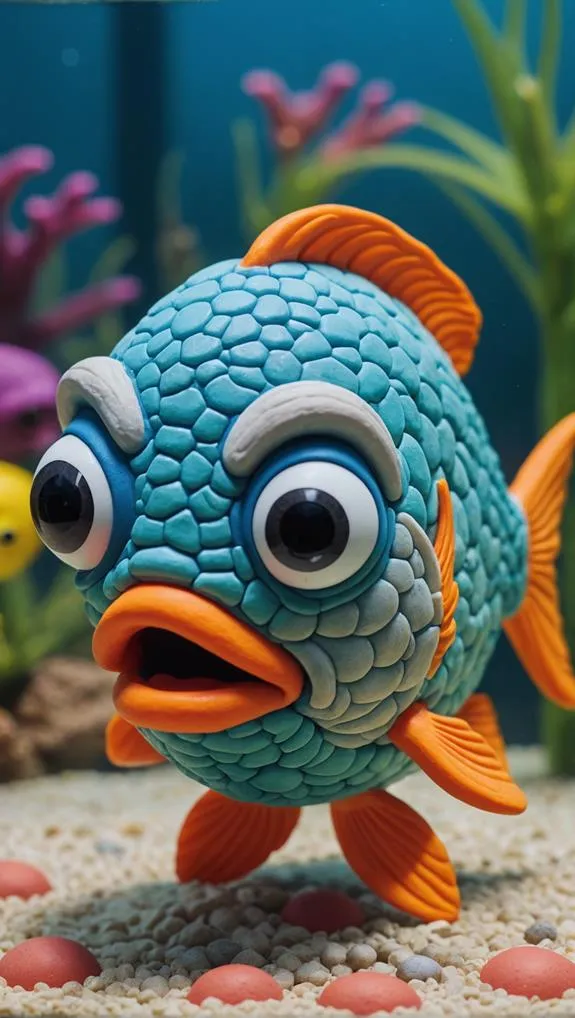
If you've noticed your fish sporting swollen or bulging eyes, it's a sign that something's amiss. This condition, often called "popeye," can indicate fluid buildup from infections or poor water quality, so it's time to act!
You'll want to check the environmental conditions in your tank. High ammonia or nitrite levels can stress your fish's body and lead to these eye issues.
Swelling usually points to bacterial infections, particularly Aeromonas, and may come with other signs like labored breathing or lethargy.
Don't forget to inspect your fish for any signs of trauma or wounds, as injuries can also cause bulging eyes.
To help your fish bounce back, focus on improving water quality and perform regular water changes. Keeping the tank clean helps ease stress on their internal organs and reduces the chances of infections.
If necessary, consider using antibacterial medications to tackle any underlying issues.
Skin Lesions and Sores
Noticing skin lesions and sores on your fish can be alarming, as these symptoms often signal significant health issues that require immediate attention. You might be dealing with bacterial infections, parasitic infestations, or even poor water quality.
It's important to act quickly, or your fish could face more serious problems down the line.
Here are a few signs to look out for:
- Open wounds or discoloration, often linked to bacterial infections like Columnaris or Aeromonas.
- Skin lesions that might indicate parasitic infestations, such as flukes or fish lice, often accompanied by excessive mucus.
- Stress-related lesions, which can arise from poor water conditions or aggressive tank mates.
If you spot these skin lesions, don't panic! Just remember that prompt treatment is key.
You could consider medicated baths or targeted antibiotics, which can help restore your fish's health. Keeping the water clean and stable can also prevent many of these issues from cropping up in the first place.
Your fish depend on you, so stay observant and proactive, and they'll thank you with their vibrant, happy swims!
Excessive Scratching Behavior
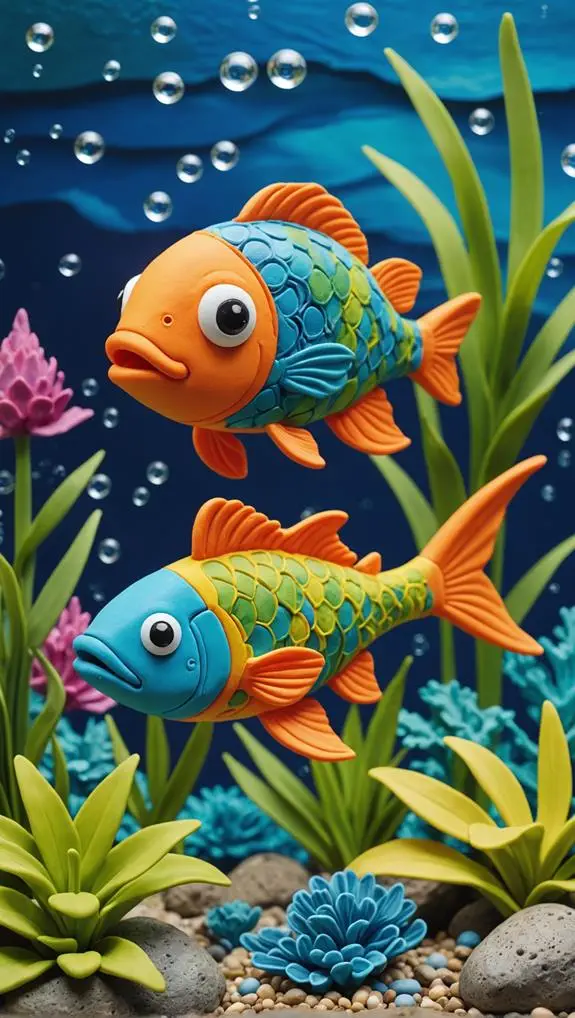
Excessive scratching behavior in fish often signals underlying irritation, typically caused by parasites like Ich or Body Flukes.
If you notice your fish rubbing against tank decorations or hard surfaces, it's a sign they're feeling uncomfortable. You might also spot them with clamped fins, seeking out quiet corners of the tank, which suggests they're not at their best.
This scratching behavior isn't just a minor nuisance; it can lead to physical injuries if it goes unchecked. Plus, poor water quality can make things worse, so it's vital to keep an eye on your tank conditions. Regularly testing your water and doing those routine cleanings can make a world of difference for your finned friends.
If you catch excessive scratching early on, you can act quickly. Consider medicated baths or anti-parasitic treatments to help relieve their irritation.
Frequently Asked Questions
What Are 4 Signs of Disease a Fish Will Possibly Display?
You might notice behavioral changes like scratching, physical symptoms such as clamped fins, stress indicators from poor water quality, or decreased appetite. Identifying these signs early helps you explore appropriate treatment options for your fish.
What Is the Most Common Disease in Fish?
Like tiny snowflakes, Ich is the most common fish disease. You can improve fish stress factors through effective fish disease prevention, maintaining aquarium water quality, and using parasite identification methods alongside common treatment options for a healthier environment.
What Is a Spot Disease in Fish?
Spot disease, commonly caused by *Ich*, shows symptoms like white spots and scratching. To treat, you can raise water temperature and use medications. Prevent it by maintaining water quality and quarantining new fish before adding them.
How Do I Know if My Fish Has a Bacterial Infection?
Wondering if your fish has a bacterial infection? Look for symptoms like lethargy or open sores. Treatment options include antibacterial medications, while prevention techniques can minimize fish stress factors and combat common bacterial strains effectively.
Final Thoughts
So, you've got a fish with a flair for drama—swimming like it just lost a game of tag and throwing a pity party in the corner? Spotting these signs of fishy diseases can feel like detective work, but don't worry, you're not auditioning for a reality show. Just remember, if your aquatic friend's acting more like a soap opera star than a happy swimmer, it's time to take action. After all, fish deserve a little TLC too!

